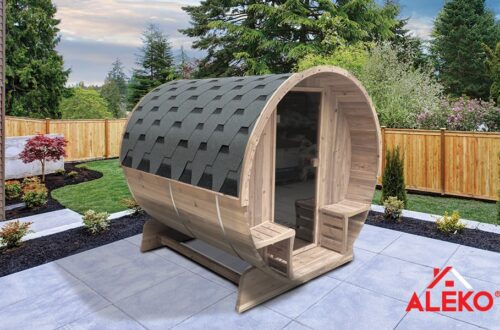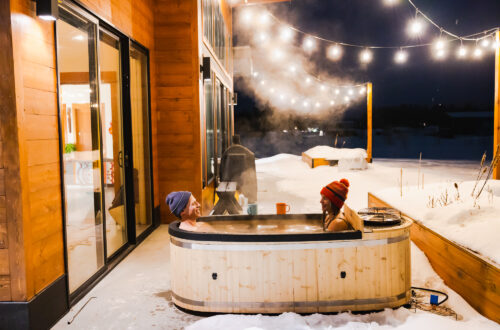If you’ve ever stepped into a sauna, you know how quickly the heat can take over, bringing on a comforting wave of warmth that feels like a hug for your whole body. But when it comes to infrared saunas, things get a bit more nuanced. Unlike traditional saunas, which heat the air around you, infrared saunas use infrared light to penetrate your skin directly, allowing you to sweat at much lower temperatures. So, what’s the best temperature for an infrared sauna session? Let’s explore the science and sweet spots behind infrared sauna temperature and find out how you can achieve maximum benefits.
The Basics: Infrared Heat vs. Traditional Sauna Heat
In a traditional sauna, such as a barrel sauna, the temperature is cranked up to around 180°F to 195°F. This high sauna temperature heats the air, making the room hot and steamy, much like a steam room. But infrared saunas work differently. When comparing traditional sauna vs infrared saunas, infrared saunas use heaters that emit infrared light (not visible to the eye) which penetrates the skin, heating the body directly without making the surrounding air unbearably hot.
As a result, an infrared sauna temperature is typically between 120°F and 140°F. Yes, it’s a lower range than traditional saunas, but don’t let that fool you—infrared saunas deliver intense heat therapy without the overwhelming high temperatures of conventional setups.
Why Infrared Sauna Temperature Matters
Temperature plays a crucial role in determining the effectiveness of your sauna session. The best temperature for infrared sauna use is one that allows you to sweat comfortably, raising your core body temperature without discomfort. While higher sauna temperatures can lead to more sweating, an ideal infrared sauna temperature strikes a balance, letting you experience all the benefits of infrared heat without overheating.
What’s the difference between feeling refreshed and totally drained after a session? That’s right—infrared sauna temperature.
So, What’s the Best Temperature for an Infrared Sauna?
Here’s where things get interesting. The best infrared sauna temperature really depends on personal preference, experience, and wellness goals. However, most users find that staying in the 120°F to 140°F range gives optimal results.
- Beginners: If you’re new to infrared sauna therapy, start at the lower end—around 100°F to 120°F. This way, your body can gradually adjust to the warmth without feeling overwhelmed. This, of course, may vary depending on how long you stay in the infrared sauna.
- Experienced Users: Those familiar with infrared saunas may find their sweet spot around 130°F to 140°F. At this range, you’ll sweat more, feel the infrared energy working deeply, and enjoy enhanced sauna therapy benefits.
Infrared Sauna Temperature Ranges for Different Goals
Your infrared sauna temperature can also vary depending on what you hope to achieve. Here’s a breakdown of suggested temperature ranges for common goals:
- Relaxation and Stress Relief (100°F – 110°F)
A lower temperature range is perfect if you’re just looking to unwind. The gentle warmth of infrared heat at around 100°F to 110°F helps calm the mind and body without pushing your core temperature too high. This range is ideal for longer sauna sessions, letting you soak up the infrared waves comfortably. - Detoxification and Skin Health (110°F – 125°F)
Want to sweat it out? Turn up the infrared sauna temperature to around 110°F to 125°F. The moderate heat encourages your body to release toxins through sweat, potentially leaving your skin looking fresher. - Weight Loss and Calorie Burning (125°F – 140°F)
For those using infrared saunas to support weight loss goals, the upper range (125°F to 140°F) is recommended. This temperature increases your body temperature, encouraging calorie burn and boosting metabolism. - Muscle Recovery and Pain Relief (130°F – 140°F)
For athletes and fitness enthusiasts, the higher temperature range of 130°F to 140°F helps with muscle recovery. Infrared heat at this level promotes blood circulation, reduces inflammation, and can relieve aches, making it ideal post-workout.
Infrared vs. Traditional Saunas: Comparing Temperature and Effects
Traditional saunas require higher temperatures—think 180°F and above—to produce a similar effect. But with infrared saunas, you get deep heating benefits without the extreme air temperatures. Unlike traditional steam saunas, which heat the air and create steam, infrared saunas are all about the direct infrared heat.
Why does this matter? With infrared saunas, you’re able to tolerate longer sauna sessions, even at lower temperatures, due to the less-intense heat surrounding you.
| Sauna Type | Temperature Range | Experience | Ideal For |
| Infrared Sauna | 120°F – 140°F | Warm, comfortable | Relaxation, detox, recovery |
| Traditional Sauna | 180°F – 195°F | Hot, intense | High-heat lovers, short sessions |
| Steam Sauna | 110°F – 115°F | Humid, moist heat | Skin health, relaxation |
How to Set Your Infrared Sauna Temperature for Best Results
If your sauna has adjustable settings, follow these steps to dial in the best infrared sauna temperature for you:
- Start Slow: Begin with a lower temperature range—around 100°F to 110°F—for shorter sessions if you’re new to saunas.
- Increase Gradually: Once your body adapts, increase the sauna temperature by a few degrees each session, building up to 130°F-140°F.
- Listen to Your Body: Everyone’s tolerance is different. If you feel dizzy, light-headed, or uncomfortably hot, lower the temperature.
- Adjust for Your Goals: Remember that infrared sauna temperatures can be tweaked based on what you want to achieve, be it relaxation, detox, or muscle recovery.
Temperature Tips: Making the Most of Your Infrared Sauna Experience
To get the most out of your infrared sauna experience, keep these temperature-related tips in mind:
- Stay Hydrated: Sweat is great for detoxing, but it also means water loss. Drink plenty of water before, during, and after your sauna session.
- Choose Comfortable Clothing: Many opt for a towel or lightweight clothing, allowing infrared light to penetrate the skin effectively.
- Preheat the Sauna: Give the sauna a few minutes to reach your desired sauna temperature. The warm-up time ensures even heating when you step inside.

FAQs: Common Questions About Infrared Sauna Temperature
1. Can I Use My Infrared Sauna at Lower Temperatures?
Absolutely! Lower temperatures can be just as beneficial, especially for longer sessions focused on relaxation and stress relief.
2. Is a Higher Temperature Always Better?
Not necessarily. While higher temperatures can amplify some effects like calorie burning, lower settings are perfect for therapeutic and relaxing sauna use.
3. What’s the Maximum Temperature for an Infrared Sauna?
Most infrared saunas cap out at around 150°F. Any higher, and you risk overheating, which can lead to dehydration or fatigue.
Wrapping It Up: The Ideal Infrared Sauna Temperature for You
When it comes to infrared sauna temperatures, there’s no one-size-fits-all answer. Your ideal temperature depends on factors like your experience level, wellness goals, and personal preference. Whether you prefer a mild 100°F or the more intense 140°F, there’s a perfect heat level for everyone.
Take some time to experiment, ease into higher temperatures, and listen to what feels best for your body. At the end of the day, the best temperature for infrared sauna sessions is the one that makes you feel relaxed, rejuvenated, and ready to face the world with a fresh glow.
Ready to experience the perfect sauna temperature in your own home? Explore ALEKO’s collection of high-quality home saunas designed to fit every wellness need and space—discover your ideal setup today!





